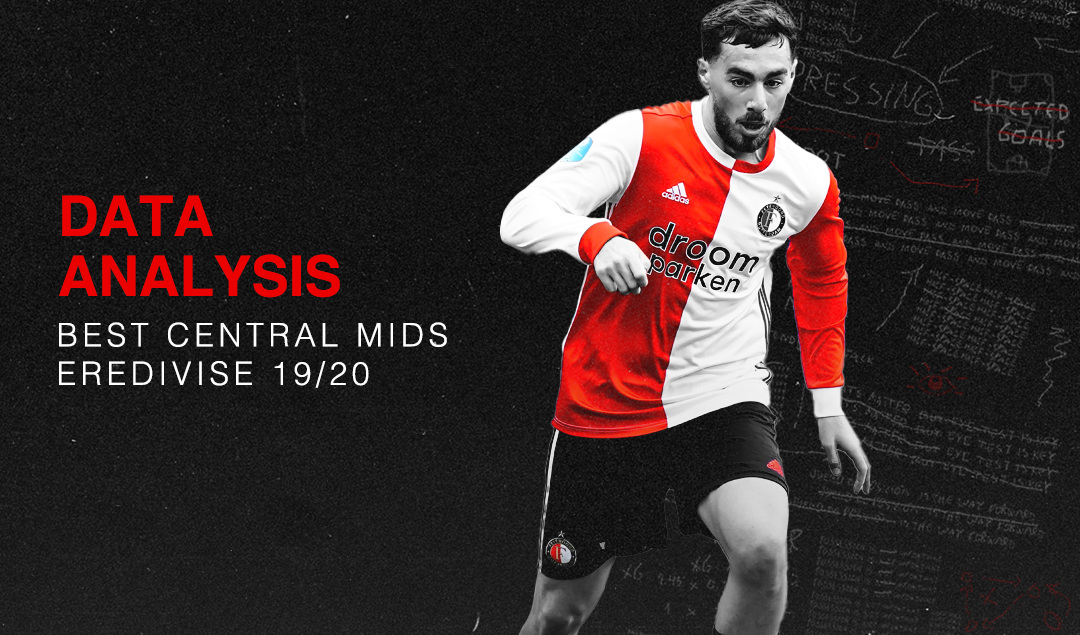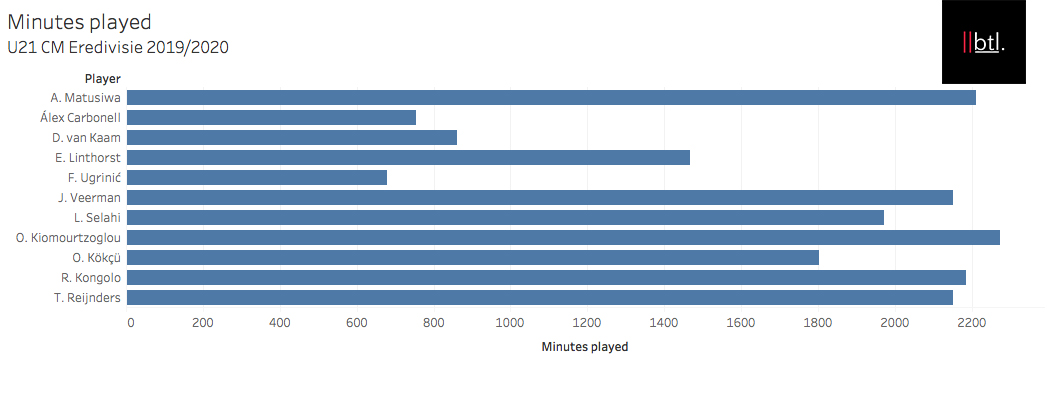The Best U-21 Central Midfielders in the Eredivisie
The 2020/21 Eredivisie season kicks off on September 12 when Willem II visit Heerenveen, and as such, it gives us a chance to reflect on the top breakout stars of last season. In Part 1 of this series, we focused on the top U-21 defensive midfielders of the 2019/20 Eredivisie season, but in Part 2, we’ll be focusing on the top U-21 central midfielders of the previous campaign.
Many Eredivisie sides play a 4-2-3-1 formation with a central midfielder playing in that double pivot or in a slightly more conservative role in an attacking midfield position. We will have a look at attacking midfielders in part 3 of our series, but now we will focus on the players who have impressed in a central midfield role.
A central midfielder is the core of the midfield, the link between the defence and the attack. This kind of player is often able to receive the ball and progress it forward to more attacking players. We are going to look at four different qualities to assess which midfielders were the best in their age group:
- Defensive ability
- Progressive runs and passes
- Dribbling
- Attacking output
To clarify the criteria, players must have been 21 years old or younger when the 2019/20 season started. Furthermore, each player must have played at least 900 minutes in the Eredivisie. There are eight players who meet both of these cut-off points.
The following players will be included in our data analysis of the top U-21 central midfielders in the 2019/20 Eredivisie season: Azor Matusiwa (FC Groningen), Evert Linthorst (VVV-Venlo), Joey Veerman (SC Heerenveen), Lindon Selahi (FC Twente), Orestis Kiomourtzoglou (Heracles Almelo), Orkun Kökçü (Feyenoord), Rodney Kongolo (SC Heerenveen), Tijani Reijnders (AZ).
Defensive Ability
First, let’s take a look at how these players shape up on the defensive side of the game. By comparing Defensive duels won with Defensive duels per 90, we can analyze how these players perform in defensive metrics.
Selahi is the most defensive-minded midfielder of the eight, averaging 12.04 defensive duels per 90 with a success rate of 57.58%. Kongolo follows with 8.36 defensive duels per 90 at a 67% success rate, the Heerenveen man placing first in terms of accuracy.
Matsuiwa finishes slightly behind Kongolo with 8.34 defensive duels per 90 at a success rate of 61.46%, whilst Kiomourtzoglou places fourth with 7.48 and 64.55%, respectively. To complete the list, Reijnders averages 6.61 and 52.53%, Linthorst with 6.57 and 55.14%, Kökçü with 6.39 and 52.34%, and Veerman with 6.27 and 58%.
Progressive Runs and Passes
One of the central midfielder’s main tasks is to link defense and attack; they must be available to receive the ball and then progress it forward to his attacking teammates. In this metric, we will compare two metrics: progressive passes per 90 and progressive runs per 90.
According to Wyscout, a dribble is considered a progressive run if:
- It is at least 30 meters closer to the opponent’s goal if the starting and finishing points are within a team’s own half
- at least 15 meters closer to the opponent’s goal if the starting and finishing points are in different halves
- at least 10 meters closer to the opponent’s goal if the starting and finishing points are in the opponent’s half
The players who stand out in this metric are Reijnders, who averages 8.03 progressive passes per 90 and 2.09 progressive runs per 90, Veerman with 11.84 progressive passes per 90 and 1.71 progressive runs per 90, and Kökçü with 7.54 progressive passes per 90 and 1.5 progressive runs per 90. These three are attacking midfielders who can make an impact on the game by progressing the ball.
Trailing behind the top three, Kongolo has 3.9 progressive passes per 90 and 1.19 progressive runs per 90, Linthorst has 5.28 progressive passes per 90 and 0.98 progressive runs per 90, Matusiwa has 7.61 progressive passes per 90 and 0.94 progressive runs per 90, Selahi has 5.15 progressive passes per 90 and 0.64 progressive runs per 90, and finally, Kiomourtzoglou has 7.44 progressive passes per 90 and 0.51 progressive runs per 90.
Dribbling
By comparing these two metrics — dribbles per 90 and dribble success rate — we can evaluate how effective these players are at dribbing and opening up space in the attacking third.
Kökçü comes out on top with 3.34 dribbles per 90 and a 58.21% success rate, whilst Reijnders (3.51 per 90 and 50%) and Selahi (3.28 and 41.67%) trail behind. Lagging behind them are Veerman (2.67 and 45.45%), Kongolo (2.47 and 48%), Kiomourtzouglou (1.86 and 53.19%), Linthorst (1.41 and 26.09%), and Matsuiwa (0.9 and 50%).
Attacking Output
Moving on from dribbling, let’s take a look at how each of these players make an impact in the final third. By comparing their final third passes per 90 and their expected assists per 90, we can get an accurate assessment of how effective these players are in advanced areas.
Three players stand out amongst the rest in this metric: Veerman averages 13.3 passes in the final third per 90, followed by Reijnders with 8.03 and Kökçü with 7.69. In terms of expected assists (xA), Kökçü leads the way with 0.19, followed by Veerman (0.16) and Reijnders (0.13).
At the bottom of the pack, Kiomourtzoglou averages 7.04 passes into the final third per 90, followed by Matusiwa (6.59), Selahi (4,33), Kongolo (4) and Linthorst (3.32). In terms of expected assists, Linthorst and Kongolo both average 0.04 xA per 90, followed by Matsuiwa and Selahi (0.03) and Kiomourtzoglou (0.01).
Orkun Kökçü
Whilst Kiomourtzoglou, Matsuiwa, Linthorst and Kongolo tended to lag behind in most of the metrics, there were four players who stood out amongst the rest, one of whom is Kökçü. The 19-year-old placed well in terms of attacking output and passing, and it’s easy to see why Arsenal and Sevilla were interested in signing him on a free transfer, before he agreed a contract extension until 2025 with Feyenoord in June.
There was a tug-of-war between Turkey and Holland for Kökçü, who had played 18 matches with Holland’s youth teams before switching over and playing twice for Turkey’s U-21 side. Having made his senior debut with Turkey last weekend in a UEFA Nations League match against Serbia, he’ll be playing for The Crescent-Stars from now on, and he’ll be looking to continue his development in Feyenoord after a breakthrough 2019/20 season.
Joey Veerman
It was another disappointing campaign for Heerenveen, who finished 10th in the Eredivisie and lost to Feyenoord in the KNVB Cup quarterfinals. However, Veerman was one of the few bright spots of their campaign, impressing in ball progression as he scored highest for progressive passes per 90 and finished second in progressive runs. After the likes of Hakim Ziyech and Marten de Roon, Veerman could be the next midfielder to impress at the Abe Lenstra Stadion before earning a bigger move.
Tijjani Reijnders
Reijnders struggled for minutes last season behind the likes of Teun Koopmeiners, Dani De Wit, and Jordy Clasie, and ended up joining RKC Waalwijk on loan in January.
However, with Koopmeiners shifting from a holding midfield role to playing in central defense, Reijnders will have more opportunities to impress for Arne Slot’s first team this season, and he’ll be looking to build on an impressive preseason and establish his place in the squad.
Lindon Selahi
Having joined FC Twente on a free transfer from Standard Liège last summer, Selahi has proven to be a revelation at the De Grolsch Veste, ranking ahead of his competitors in terms of defensive data while also scoring well in terms of dribbling. He has been linked with Celtic and will continue to draw interest if he builds on an impressive debut season in Holland.
By: Marc Lamberts
Featured Image: @GabFoligno / Getty Images





